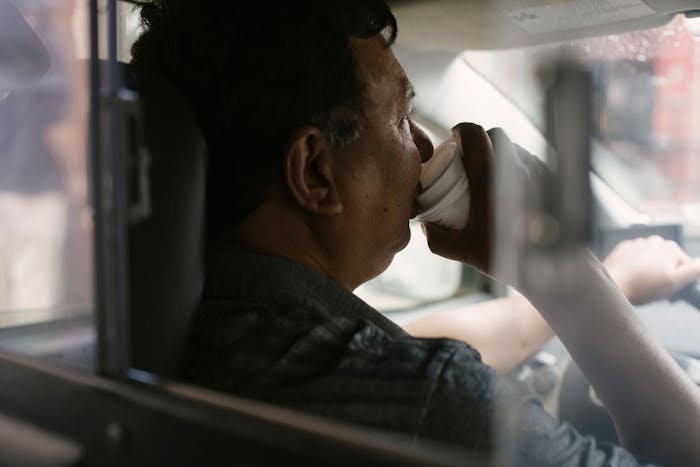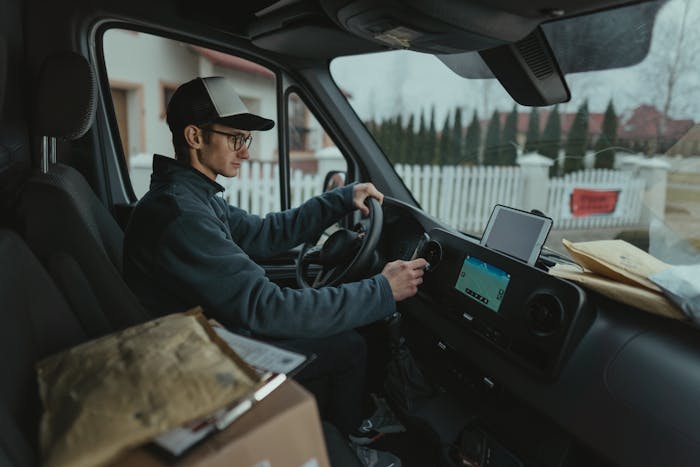Personal conveyance can be tricky for owner-operators who provide delivery services.
The Federal Motor Carrier Safety Administration (FMCSA) says personal conveyance is when a commercial motor vehicle (CMV) is used for personal reasons while off duty.
This includes driving a CMV from a truck stop to a restaurant.
Delivery or truck drivers should record personal conveyance when off the clock.
It seems simple, but personal conveyance can confuse truck drivers and fleet managers who need to be sure when it's allowed.
It’s important to address this issue because it can boost both safety and compliance for your business.
If you want to manage your delivery drivers effectively, you need to understand personal conveyance.
We'll explain what personal conveyance is and when drivers can use it. This way, you can make sure your drivers are using it correctly.
What Does Personal Conveyance Mean?
Personal conveyance is when a commercial motor vehicle (CMV) is used for personal reasons while the driver is off duty.
In other words, a delivery or truck driver who’s not working (like during a ten-hour break) can use their vehicle to grab a meal or go shopping.
Yet, there are some rules and limitations.
A driver can only mark this time as "off-duty" if they’re completely off work and don’t have any other job-related tasks.
So, if your driver is on a ten-hour break but you ask them to do something work-related, they can’t count that time as off-duty.
Even if a CMV is loaded, the driver can still use it for personal conveyance as long as the load isn’t being moved for the motor carrier's business.
This is key because it means that if your driver has a load in the vehicle, they can still use it for personal reasons. This is true as long as they’re not transporting the load for work.
However, using a vehicle for personal reasons doesn’t take away the driver’s or carrier’s duty to drive the CMV safely.
So, even if your driver is using the work vehicle for personal reasons, they’re still responsible for driving it safely.
What counts as a commercial motor vehicle (CMV)?
A vehicle is considered a commercial motor vehicle (CMV) if it meets at least one of these conditions:
- It has a gross vehicle weight rating (GVWR), gross vehicle weight (GVW), and gross combination weight (GCW). Or, a gross combination weight rating (GCWR) of 10,001 pounds or greater, whichever is higher.
- It’s designed to carry more than eight passengers (including the driver) for payment, like a city bus that charges a fare.
- It’s built to carry 16 or more passengers (including the driver) but isn’t used for paid transportation, such as a school bus.
- It’s used to transport hazardous materials in amounts that require the vehicle to have signage identifying the hazard class.
If your delivery vehicles don’t meet any of these conditions, they’re not considered CMVs.
Companies with CMVs must follow the FMCSA’s Hours of Service (HOS) regulations.
What Counts as “Off-Duty” When Using a CMV?
Personal conveyance depends a lot on whether the driver is on or off duty.
Drivers who are on duty can’t use personal conveyance—it’s only for when they’re off duty.
So, what activities are considered “off-duty” when using a CMV?
Here are some clear examples of off-duty activities that fit the personal conveyance rules:
- Driving between home and work. When your drivers go back and forth from your warehouse or a work site to their home, this counts as personal conveyance.
- Traveling from temporary lodging to a restaurant or entertainment spot. If the driver is off duty and not working, traveling from a truck stop or other temporary lodging to a place like a restaurant or a movie theater can be considered personal conveyance.
- Going to a safe place to rest after loading or unloading. Sometimes, drivers need to go to a nearby safe spot to rest after they’ve finished loading or unloading. The rest area should be close enough so the driver can get enough sleep before going back to work.
- Moving a CMV at a police officer’s or safety official’s request while off duty. If a police officer asks a driver to move the vehicle while they are off duty, this counts as personal conveyance.
- Transporting personal items while off duty. If an off-duty driver uses their CMV to pick up a part from an auto parts store for their own vehicle or a project they’re working on at home, that’s personal conveyance.
- Traveling home in a CMV after working off-site. This refers to using a CMV to go home after working at a different location, like a base camp near a construction site.
When Can Drivers Use Personal Conveyance?
The rules might seem simple, but there’s been some confusion, especially with electronic logging devices (ELDs).
Before ELDs, drivers tracked their hours manually, often on paper, which made it harder for companies to monitor HOS and personal conveyance.
Now, all trailer movements are recorded electronically, so drivers and companies need to make sure these movements are properly categorized to stay compliant.
This has caused some confusion about what driving should be considered personal conveyance and when it can be used.
One key question to ask is, “Is the driver using the CMV just for personal reasons?”
For it to be personal conveyance, the driver’s use of the CMV while off duty must not be related to their job or benefit the motor carrier.
Another point to think about is, “Can the driver decide on their own activities?”
If the driver can pick what they do while off duty, it’s likely personal conveyance.
Remember, the vehicle can be fully loaded, and it might still count as personal conveyance.
In the end, it depends on why the vehicle is being moved, not whether it’s loaded or empty.

How to Tell if Drivers Are Using Personal Conveyance Correctly
You don’t need to overcomplicate personal conveyance.
Here are some checks that delivery and fleet managers, the Department of Transportation (DOT), and law enforcement use to figure out if drivers are using personal conveyance correctly:
- Is the driver fatigued or sick and unable to drive safely? If they need to find a safe place to rest to meet HOS rules, this travel time counts as personal conveyance.
- Is the driver off duty? For the movement to be considered personal conveyance, the driver must be off duty.
- Is the trip purely for personal reasons with no benefit to the business? If the driver is moving the CMV for personal reasons and it doesn’t help the company, it might be personal conveyance.
- Is the driver looking for the nearest, safe parking spot? If the driver is searching for a safe place to park without blocking traffic or creating a hazard, it’s likely personal conveyance.
Examples of Proper Personal Conveyance While Off-Duty
Here are some situations when it’s okay to use a CMV while the driver is off-duty:
- A driver wants to go to a restaurant for dinner while off-duty.
- A driver wants to visit a movie theater while off-duty.
- A driver wants to stop by a friend’s place while off-duty.
- A driver needs to run a personal errand while off-duty.
- A driver is asked by a police officer to move their vehicle while off-duty.
Examples of CMV Use That Doesn't Count as Personal Conveyance
Here are some situations when using a CMV doesn't count as personal conveyance:
- A driver is on duty and wants to go to a restaurant for dinner.
- The motor carrier asks the driver to move their vehicle to help with traffic.
- A driver wants to visit a friend who lives 100 miles away.
- A driver wants to go sightseeing while on their delivery route.
- A driver tries to use personal conveyance to extend their driving time.
How Personal Conveyance Impacts Your Business
If you run a delivery logistics company, it’s important to understand personal conveyance rules and how they affect your business.
For example, if a driver is heading to a delivery and gets stuck in traffic, they might use personal conveyance to reroute and avoid being late.
This could help the driver arrive earlier and finish the delivery sooner than expected.
This may affect your delivery schedule.
Personal conveyance helps drivers follow HOS rules while still getting their job done.
Since personal conveyance happens during a driver’s personal time, it doesn’t count towards their HOS.
This means drivers can use personal conveyance without changing their on-duty status.
When used correctly, personal conveyance can benefit your business by:
- Reducing the chance of HOS violations
- Boosting driver productivity
- Ensuring drivers can get food, fuel, and other essentials
- Allowing drivers to travel between work sites
But if personal conveyance isn’t used properly, it can also hurt your business.
For instance, if a driver uses personal conveyance to extend their driving time, it could lead to HOS violations and potentially cost your business thousands in fines.

How to Prevent Misuse of Personal Conveyance
Here are a few ways to help prevent your drivers from misusing personal conveyance:
Create a “Personal Use Policy”
Set clear rules and expectations for your drivers. Explain what counts as personal use and what doesn’t. Use DOT regulations, ELD rules, and trucking industry best practices to make a policy that fits your business.
Enforce Your Policy
Provide your drivers with proper training and answer any questions about the personal use policy. If a driver breaks the policy, take appropriate action. This could range from a verbal warning to termination, depending on how serious the violation is.
Wrapping Up on Personal Conveyance
Personal conveyance can be tricky, so it’s crucial to understand the proper use and regulatory guidelines.
Misusing personal conveyance can lead to trouble with the DOT and affect your delivery management if drivers use company vehicles incorrectly and risk violating HOS rules.
The goal isn’t just to stay compliant.
You also want to make your drivers more efficient and productive.
If you want to boost your team’s delivery efficiency, consider eLogii route optimization software.
It can save hours on delivery, help optimize routes for all your drivers, and make managing multiple drivers easier.
eLogii also keeps customers updated with delivery status and provides proof of delivery when a job is done.